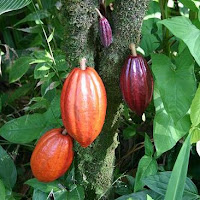 |
| picture from chocolate-world.net |
It is also known as baking chocolate, pure chocolate or bitter chocolate. Unsweetened chocolate is made from pure chocolate liquor that has been refined and contains 50-55% of cocoa butter. Although it looks and smells like chocolate, it has a bitter taste and is not suitable for eating.
What can Unsweetened chocolate do?
Since no sugar has been added to the chocolate it has a strong, bitter taste that is used in cooking and baking. It is popularly used as the base for cakes, brownies, confections, and cookies. Many bakers prefer this type of chocolate for baking because they have more control over the flavor and sweetness.
 |
| picture from hitflavor.com |
Couverture chocolate
 |
| picture from chocogram.com.au |
What can Couverture chocolate do?
It is used largely for candy making as it solidifies after melting to a glossy, thin layer mainly for the purpose of coating. It is often used by professional pastry chefs in many famous chocolate manufacturers such as Valrhona, Felchlin, Lindt & Sprüngli, Scharffen Berger, Cacao Barry, Callebaut, and Guittard.Gianduja chocolate
 |
| picture from flickr.com/photos/hellokitty893112/388347878/ |
What can it do?
Gianduja chocolate can be used as a flavoring or as a substitute for milk or dark chocolate. At room temperature it is soft enough to be rolled or cut, but is too soft to use for molding chocolates.
Milk chocolate
 |
| picture from treehugger.com |
*Milk chocolates are common chocolates that most people will eat.
What can it do?
As the more chocolate liquor added the more delicious it gets, this type of chocolate is most commonly used for the purpose of decoration. It is seldom used for baking, except for cookies.
White chocolate
White chocolate gets its name from the cocoa butter it contains, but does not contain chocolate liquor or any other cocoa products. As a result, it has no pronounced chocolate taste, but commonly tastes like vanilla or other added flavorings. By law, white chocolate must contain a minimum 20% cocoa butter, 14% milk solids, and a maximum of 55% sugar. There are some “white chocolate” products available that contain vegetable fats instead of cocoa butter—these should be avoided from a taste standpoint, as they contain no cocoa products at all, and are not technically white chocolate.
What can it do?
It has a mild and pleasant flavor and can be used to make Chocolate Mousse, Panna Cotta and other desserts.
What can it do?
As the more chocolate liquor added the more delicious it gets, this type of chocolate is most commonly used for the purpose of decoration. It is seldom used for baking, except for cookies.
 |
| picture from foodnouveau. com |
White chocolate
White chocolate gets its name from the cocoa butter it contains, but does not contain chocolate liquor or any other cocoa products. As a result, it has no pronounced chocolate taste, but commonly tastes like vanilla or other added flavorings. By law, white chocolate must contain a minimum 20% cocoa butter, 14% milk solids, and a maximum of 55% sugar. There are some “white chocolate” products available that contain vegetable fats instead of cocoa butter—these should be avoided from a taste standpoint, as they contain no cocoa products at all, and are not technically white chocolate.
What can it do?
It has a mild and pleasant flavor and can be used to make Chocolate Mousse, Panna Cotta and other desserts.
References:
1. Different Types of Chocolates and Their Uses. (2010, January 8). Retrieved April 30, 2011, from top54u.com: http://health.top54u.com/post/Types-of-Chocolates.aspx
2. LaBau, E. (2011). A Guide to Chocolate Varieties. Retrieved April 30, 2011, from about.com: http://candy.about.com/od/candybasics/a/chocguide.htm
3. McSweeney, L. W. (2003, April 18). Chocolate Simplified. Retrieved April 30, 2011, from suite101.com: http://www.suite101.com/article.cfm/cooking_basics/99847
4. Types of Chocolate. (2010). Retrieved April 30, 2011, from facts-about-chocolate.com: http://www.facts-about-chocolate.com/types-of-chocolate.html








